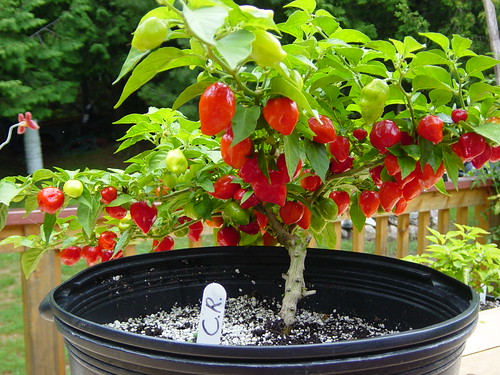After re-reading your posts again, the above quotes clearly contradict each other. I feel like you are desperately trying to prove me wrong about something, and I just don't get it. Either you believe the CRH is a Habanero or you don't. You can't have it both ways.
There seems to be some grey area here with the CRH anyway, because if there was a clear answer, this thread would have died long ago. My last post merely stated that perhaps there is a Caribbean Red AND a Caribbean Red Habanero. This could have arisen from people misnaming things over time...who is to say. In case you were interested, the picture of the CRH used in "The Complete Chile Pepper Book," which was co-authored by Paul Bosland from NMSU CPI, looks exactly like Potawie's picture of his plant, and it is what I hope mine look like as well. Like I said earlier, I'll let you know what it looks like when it grows out.
Bottom line, without DNA tests, there is no way to authoritatively back up any claims on whether or not the CRH shown in Potawie's pic (Which I think even you would agree is true to type) is a true Habanero. The best we have to go by are phenotype and origin, and to me, it looks damn close to an orange Habanero, but red. You have your opinion and I have mine.
I don't know if you have noticed but throughout this thread, my posts are not geared toward proving you wrong, but more about finding out a bit more information on the origins of a pepper I am growing this season. I am fine with people stating their opinions, and I welcome them. Potawie brought some interesting information to the table about the connection to Monsanto that neither you nor I knew about. I'm sure there are some other things you don't know about as well. How about we just keep the focus on bringing more information to the table, yeah?
Not trying to prove you wrong.
The part where I said "All Caribbean Reds are Habaneros, but not all red Habaneros are Caribbean Reds" had a different meaning than the one you keep using, AND I ALREADY EXPLAINED MYSELF. will explain in again and I hope you won't choose to ignore it also.
The discussion started with how people think every red C. chinense with a hab-like shape is Caribbean Red, so I referred to C. chinense chiles as "Habaneros" to make a point. the point was not every C. chinense is Caribbean Red, not how Caribbean Red is a Habanero.
Now let me try and explain myself even better.
I think we already cleared that "Habanero" in its real sense is not that general, so not every C. chinense would be qualified to be named such. it doesn't matter what shape it is or what color it is... it's a complex thing. trying to dig in even further will take a lifetime.
This debate became what it is today, for me at least, when you stated it was clear the Caribbean Red is a Habanero and would like to see how the Habaneros compare to Scotch Bonnets. that made me understand how you don't use Habanero in the general sense of C. chinense chiles and see them as a standalone sub-group inside the C. chinense species. I disagreed and tried to explain that to you in stating it is not even a real Habanero. not all C. chinense are Habaneros. now throughout all of this debate you had comments such as "it's a Habanero, it's red... so it's a red Habanero" which is setting facts, that I don't agree with. let's just say I am just a simple man and do not, and ever will not, know everything about everything. the Caribbean Red might be a a real Habanero and it might not, I can't 100% say. so can't you. the info I learned over the years indicates it isn't. the point where you insisted it's a true Habanero and I'm trying to twist the truth was wrong. one of your claims was that NMSU's catalog backs up your statement it is a Habanero, and you know what? their "Red Caribbean Habanero" might be a real Habanero, might not... I personally think it isn't, but it doesn't matter. it's not even the same chile we're discussing here, just look at the picture. this leads me to another point I never referred to before, but you just have - there are multiple DIFFERENT chiles with the name "Caribbean Red". some are short, some long, some are round, some are pointy and so on... they are all called "Habaneros" and in my opinion none of them truly is. most of them share certain qualities such as heat, flavor etc... some are called such just because they're from the Caribbean, even though the common chile we refer to as Caribbean Red is not from the Caribbean. yes, we already talked about it... no need to correct me. in my eyes Mexico chiles are not the same as the ones in the Caribbean islands.
Well that's about it. my opinion.
I hope it was clear enough this time.







